Giáo trình Tiếng Anh chuyên ngành kỹ thuật máy lạnh và điều hòa không khí
Units of Heat
The amount of heat added to, or subtracted from, a body can best be
measured by the rise or fall in temperature of a known weight of a substance.
The standard unit of heat measure is the amount of heat necessary to raise the
temperature of 1 pound of water 1°F at sea level when the water temperature
is between 32°F and 212°F. Conversely, it is also the amount of heat that
must be extracted to lower by 1oF the temperature of a pound of water
between the same temperature limits. This unit of heat is called a British
thermal unit (Btu). The Btu's equivalent in the metric system is the calorie,
which is the amount of heat required to raise one gram of water 1 o Celsius.
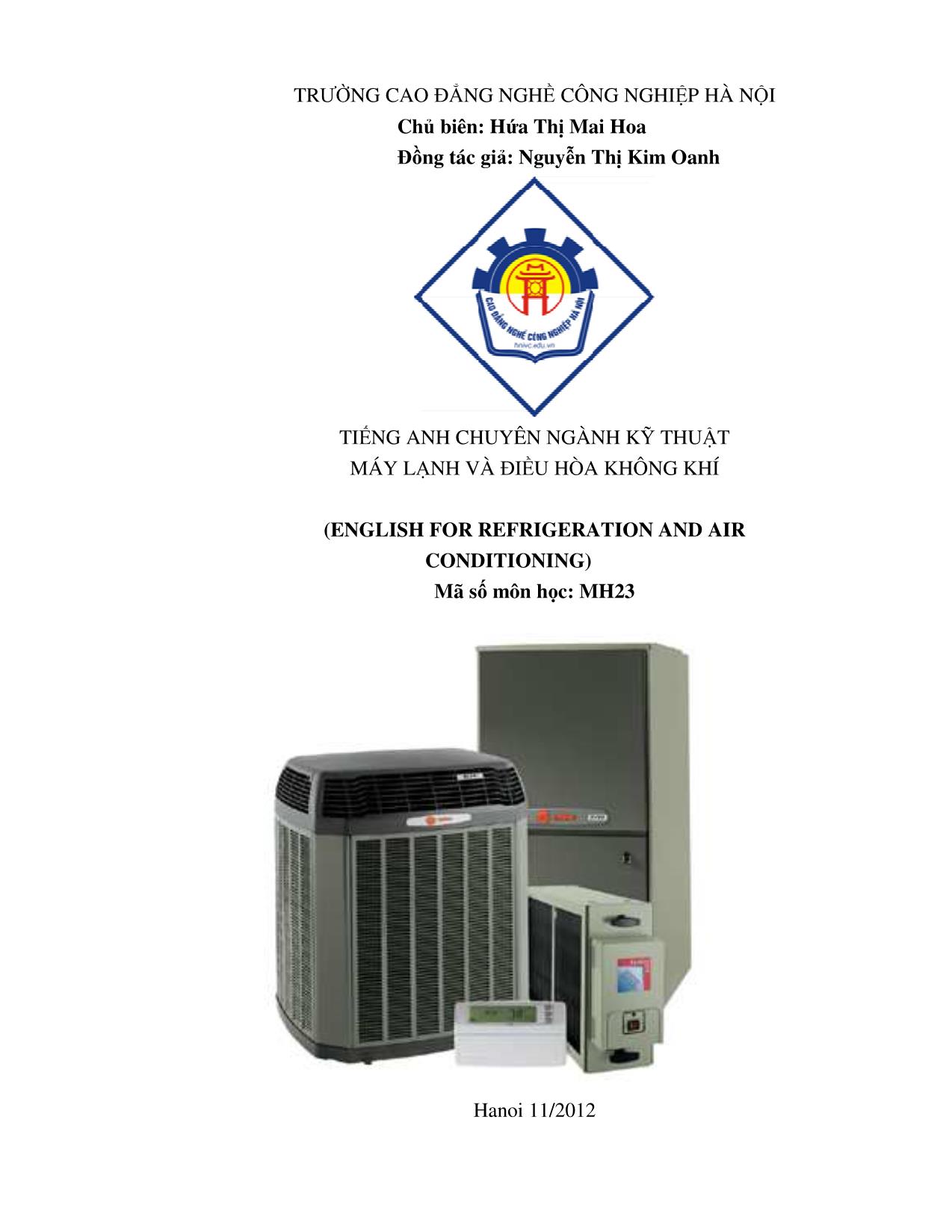
Trang 1
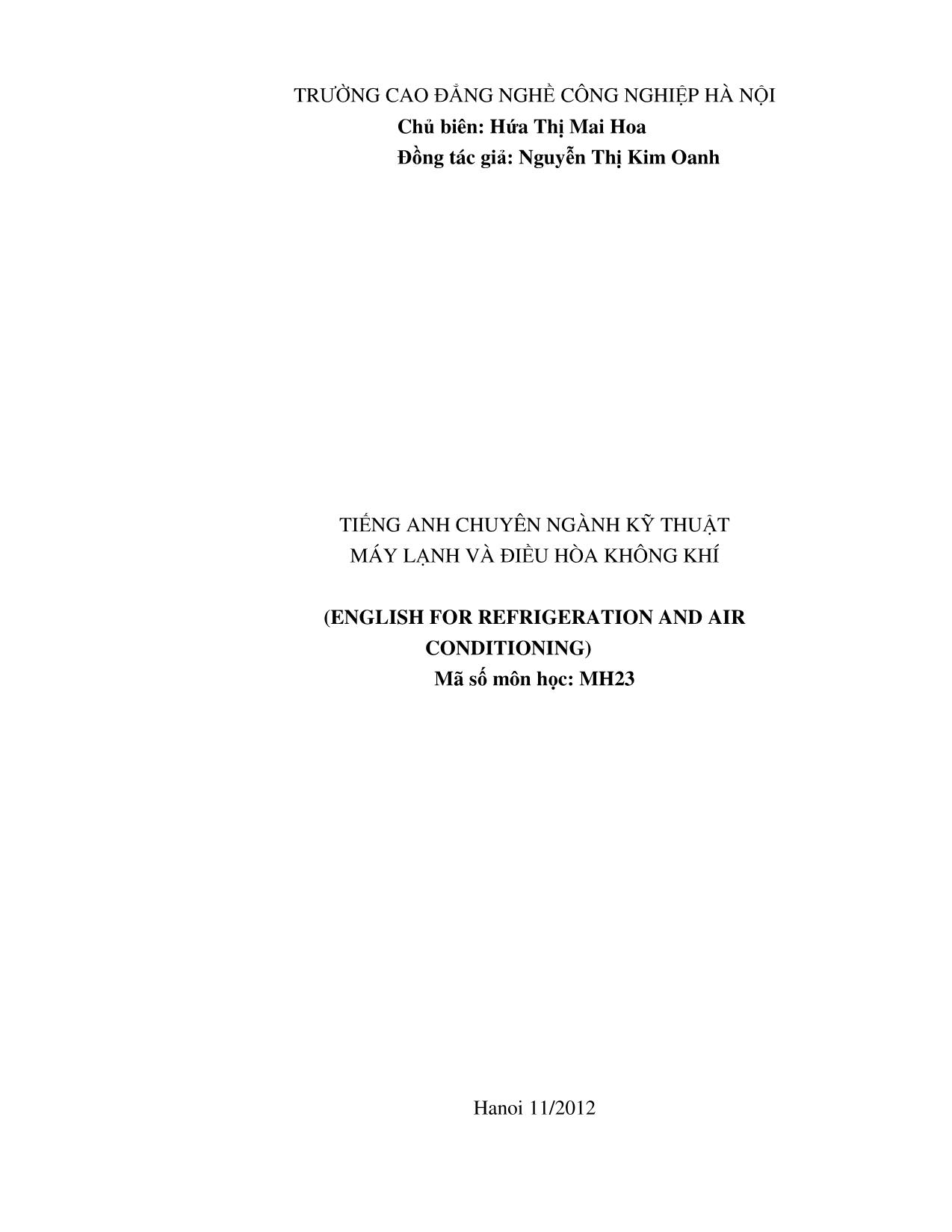
Trang 2
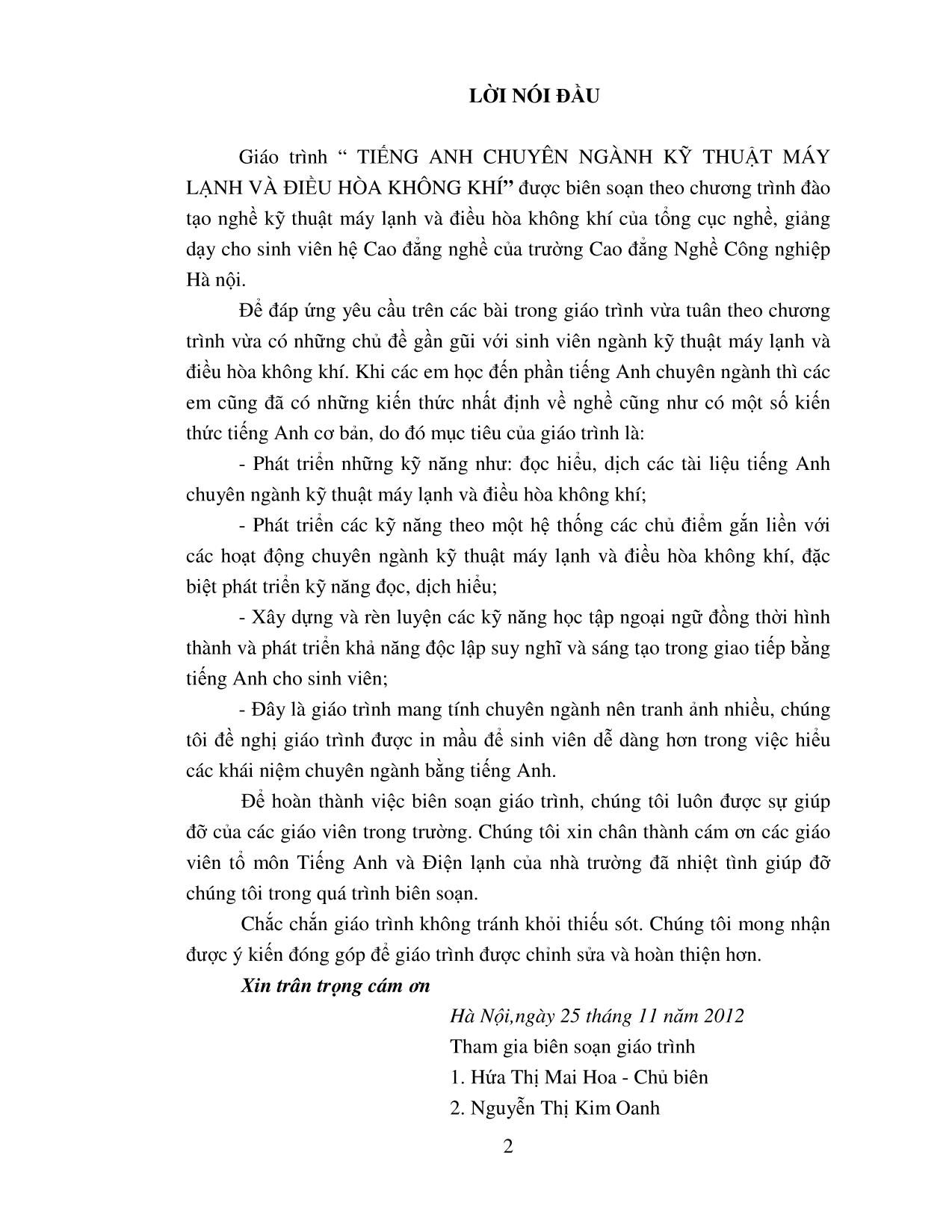
Trang 3
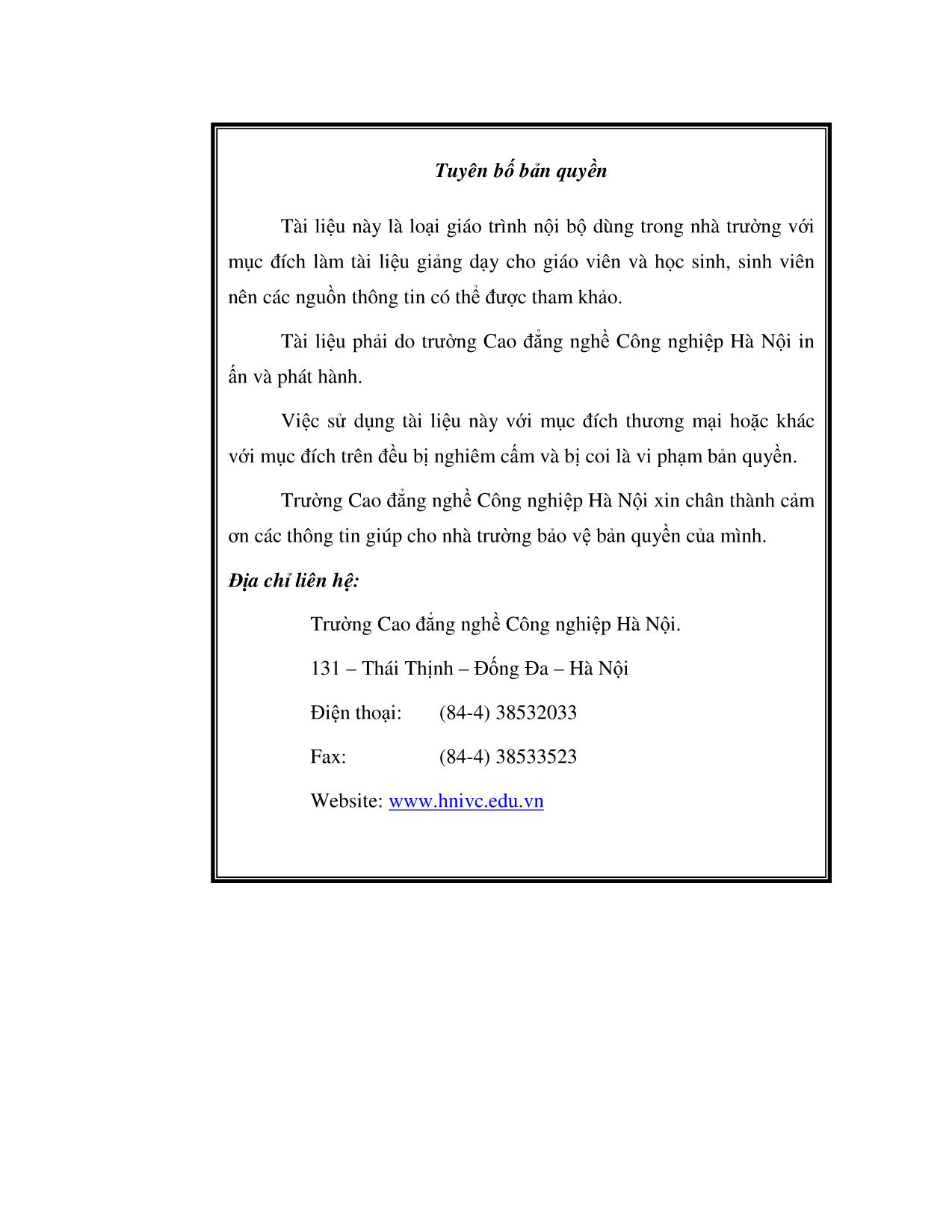
Trang 4
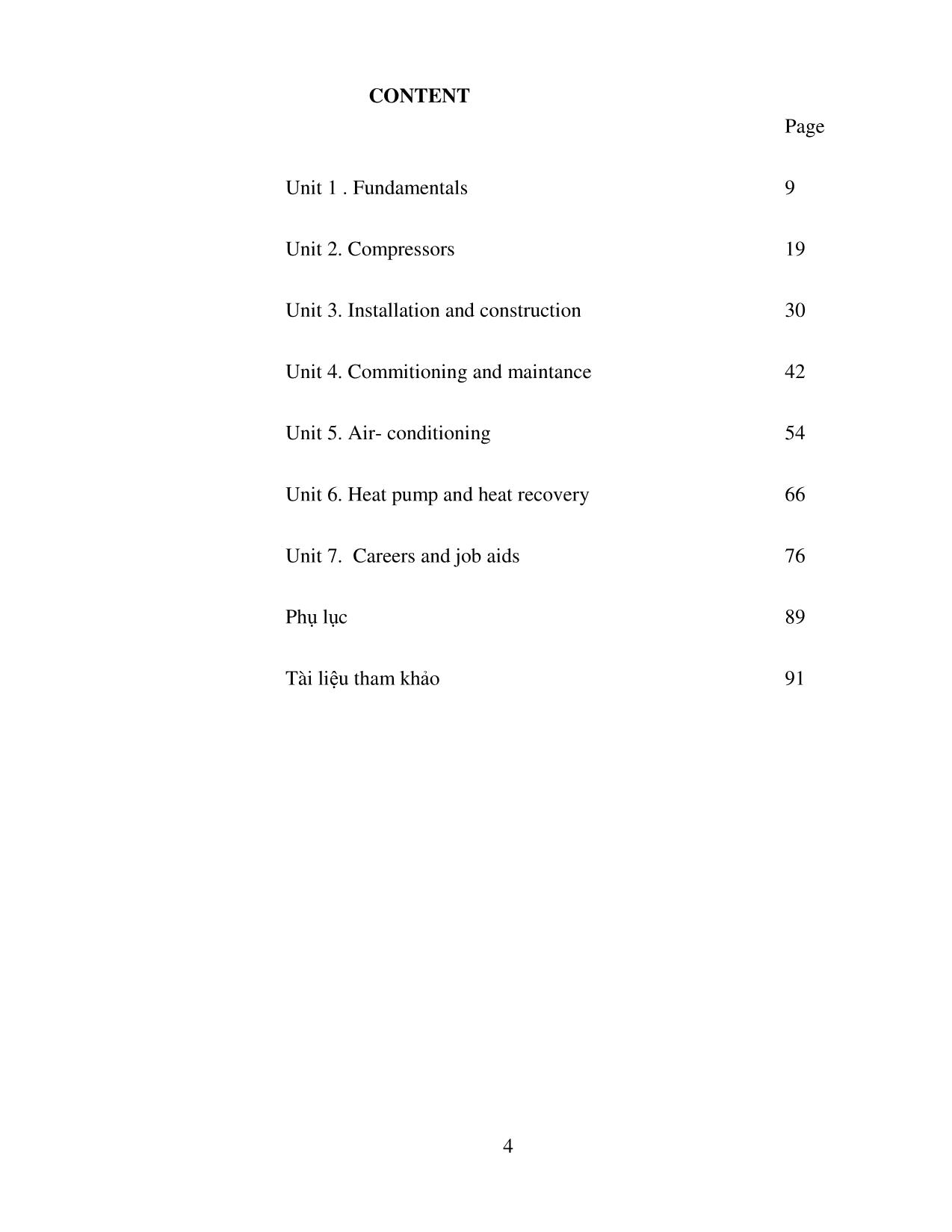
Trang 5
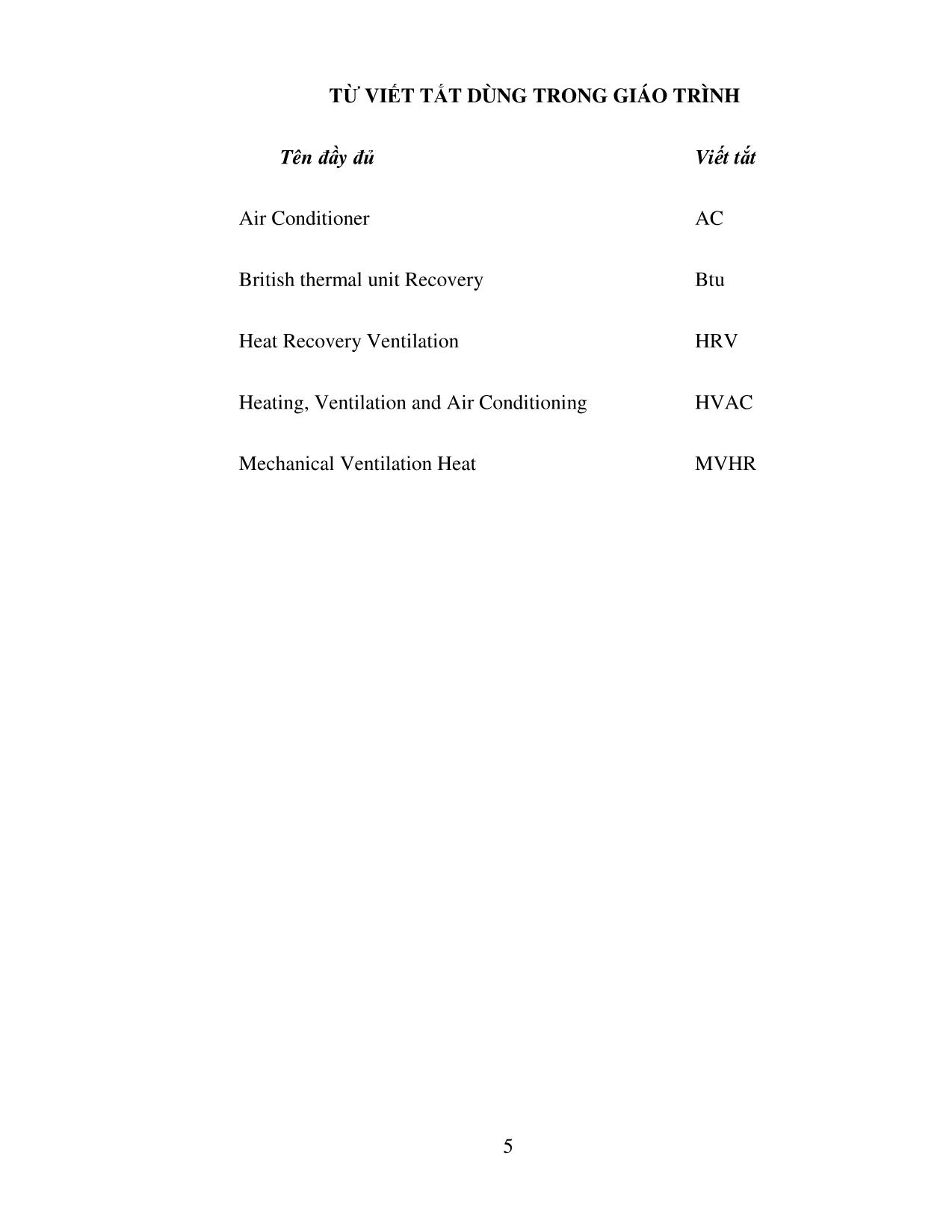
Trang 6
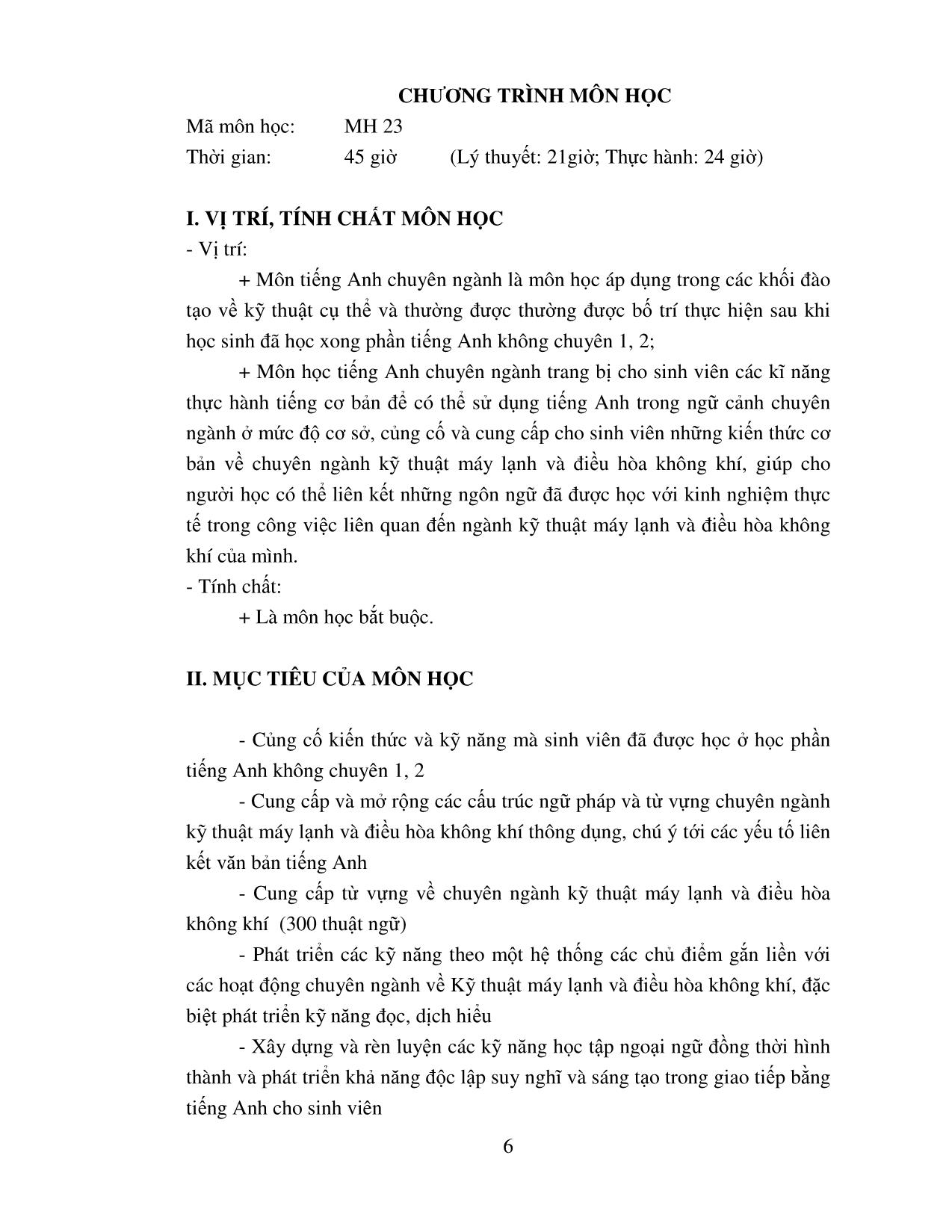
Trang 7
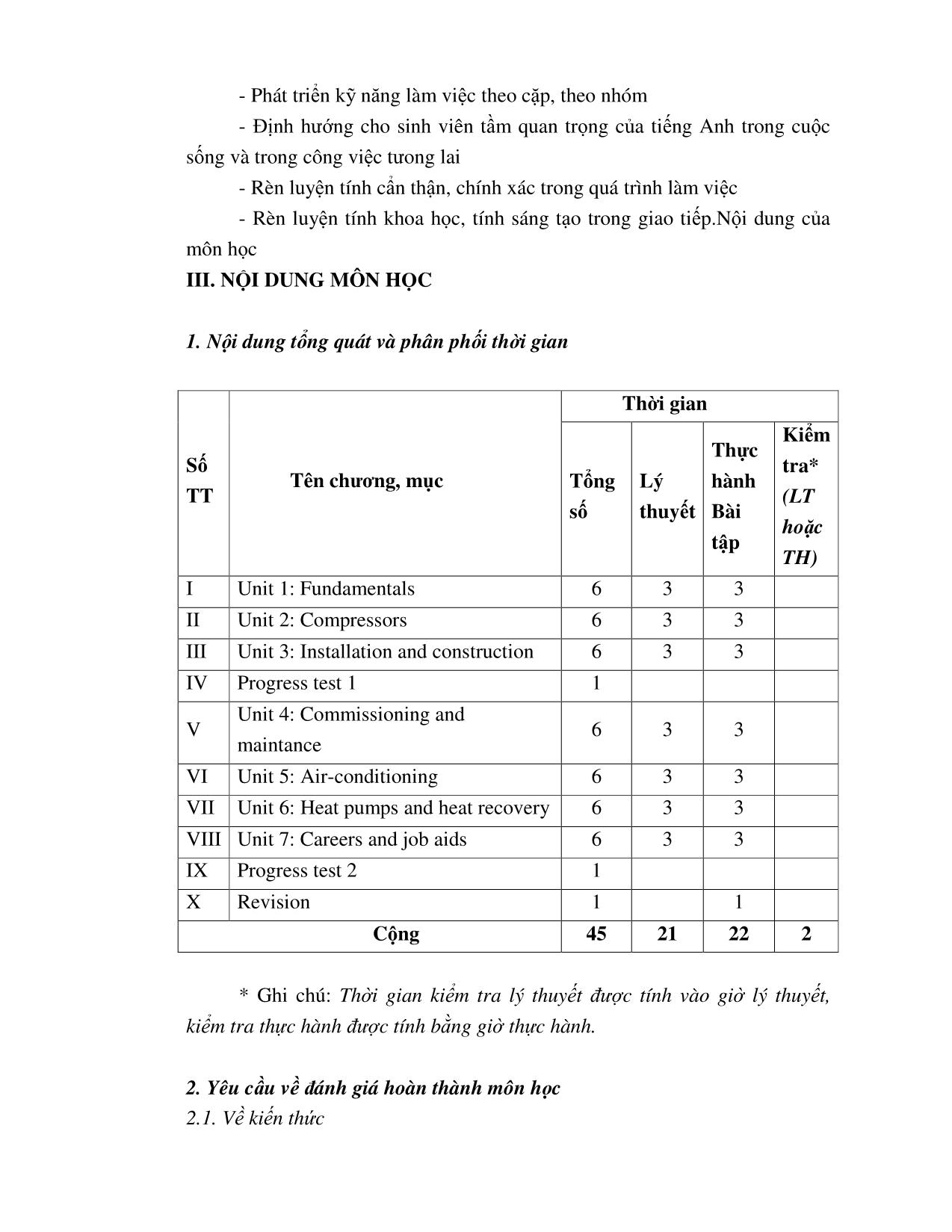
Trang 8
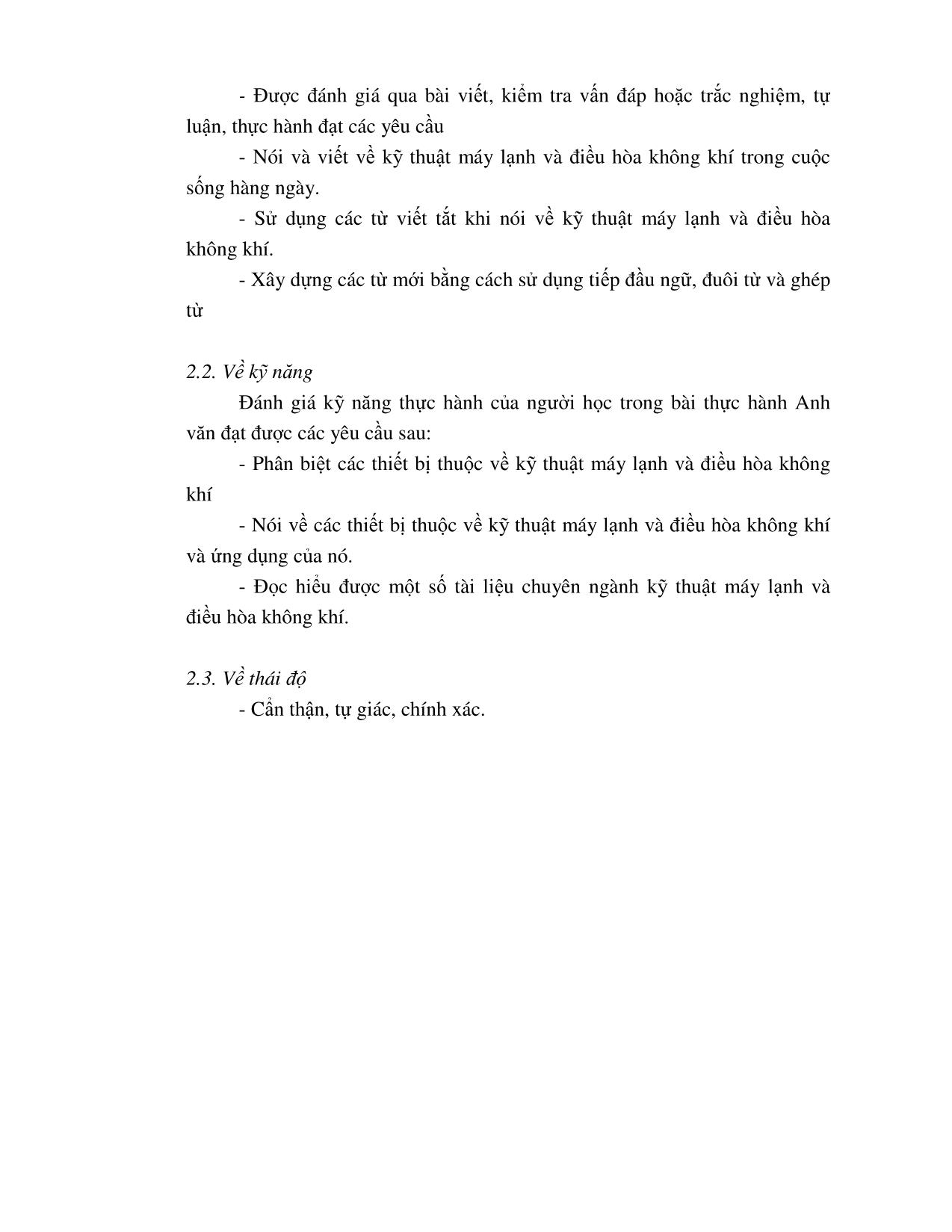
Trang 9
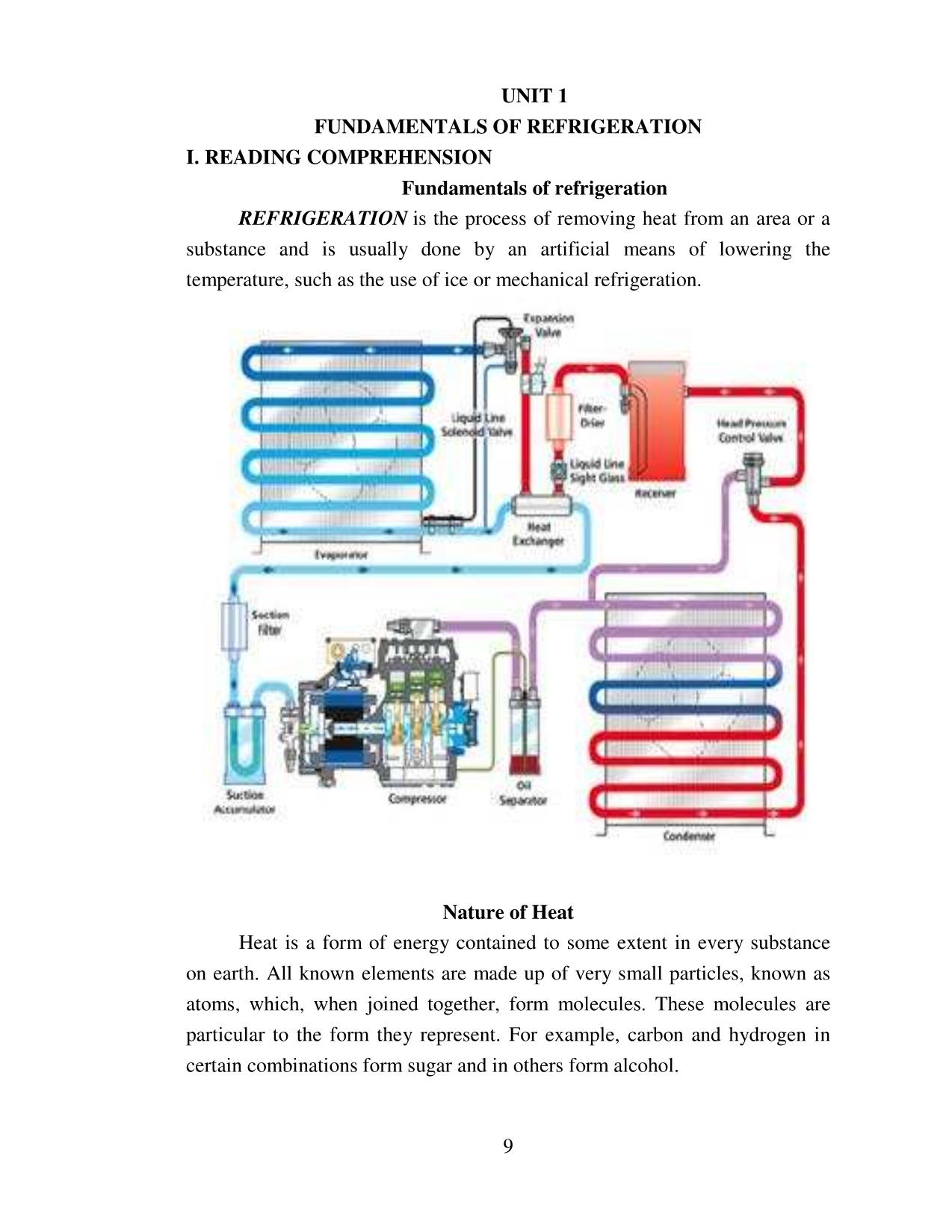
Trang 10
Tải về để xem bản đầy đủ
Tóm tắt nội dung tài liệu: Giáo trình Tiếng Anh chuyên ngành kỹ thuật máy lạnh và điều hòa không khí
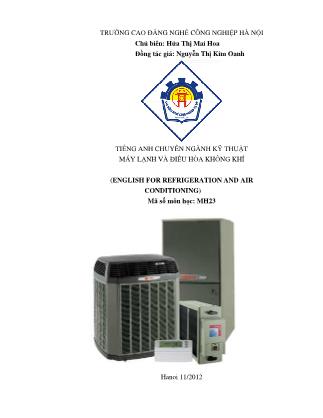
jobs": Coordinating conjunctions are used to join two parts of a sentence that are grammatically equal. The two parts may be single words or clauses, for example: - Air-conditioning and heating equipment makes the air inside buildings cool in summer and warm in winter. Subordinating conjunctions are used to join a subordinate dependent clause to a main clause, for example: - Because they must connect ducts and refrigerant (cooling) lines, mechanics must know how to weld and fit pipe. Position - Coordinating conjunctions always come between the words or clauses that they join. - Subordinating conjunctions usually come at the beginning of the subordinate clause. - A machine or unit may be large enough to cool an entire building or small enough to fit into a window to cool only one room. - Once the furnace or heating unit is in place, the installer must test it to make sure it is working properly. III. PRACTICE Exercise 1. Rearrange these words to make the sentences 1. refrigerant /through /The /flows /the/ heat /system /transfers / and .. 2. offer / vocational /Many /colleges/ courses / and /in / refrigeration. /air- conditioning .. 3. also /Job /should /know/ microelectronics./ something/ seekers/ about .. 4. as /Wages/ trainee's/ increase /the / grows./skill .. 5. years /Apprenticeships./usually /four / last .. Exercise 2. Match the words in A to the appropriate phrase in B A B 1. Air-conditioning and heating equipment a. make up refrigeration or air-conditioning units. 2. Refrigeration machines b. the Yellow Pages 3. Mechanics c. may have job information. 4. air-conditioning mechanics d. put in oil, gas, electric, and multifuel heating systems. 5. Furnace installers e. install and repair many different sizes of machines. 6. A good place to start f. specialize in installation or in maintenance and repair. 7. Fuel oil dealers and gas utility companies g. makes the air inside buildings cool in summer and warm in winter. 8. Air-conditioning and refrigeration mechanics h. to install the motors, compressors, condensing units, evaporators, pipes, and ducts 9. The mechanics follow blueprints and manufacturers' instructions i. make ice and to keep food cool or frozen. 10. blueprints and manufacturers' instructions j. inspect the systems and do overhauling compressors. Exercise 3. Put a word to a suitable space to complete the passage contractors ; mechanics; occupations ; supervisors; electronics ; refrigeration Advancement Possibilities and Employment Outlook Air-conditioning, heating, and refrigeration are already at the top of their craft. They may advance to become .or be given responsibility for servicing all of the units in a certain area. Some mechanics start their own service and repair shops or become .or equipment suppliers. Employment in this occupation is expected to grow faster than the average for all . through the year 2014. The need for air- conditioning, heating, and.. mechanics will increase with the construction of new buildings, and many job openings will result from the need to replace workers who retire or leave the workforce. Mechanics will be needed to replace old systems and to service the increasingly complex of new systems, in part because of new laws requiring more efficient units. Exercise 4. Translate the sentences into Vietnamese 1. Air-conditioning and heating equipment makes the air inside buildings cool in summer and warm in winter. This equipment is also used in cars, buses, and trains. . . . . 2. Mechanics may specialize in one type of equipment. These specialists are called air-conditioning and refrigeration mechanics, furnace installers, oil burner mechanics,and`gas`burner`mechanics. . . . . 3. Air-conditioning and refrigeration mechanics install and repair many different sizes`of`machines. . . 4.A machine or unit may be large enough to cool an entire building or small enough to fit into a window to cool only one room . . . . 5. Air-conditioning, heating, and refrigeration systems are becoming more sophisticated. While it is still possible to enter this field through informal on- the-job training, most employers prefer to hire workers with technical school or apprenticeship`training. . . . Exercise 5. Translate the sentences into English 1. Vì họ phải kết nối các ống dẫn và dây chuyền làm lạnh (làm mát), những người thợ phải biết làm thế nào để hàn và nối đường ống. . . 2. Khi điều hòa không khí hoặc thiết bị làm lạnh bị phá vỡ, những người thợ xác định nguyên nhân và sửa chữa. . . . 3. Những người thợ lắp đặt lò sưởi theo bản thiết kế và hướng dẫn của nhà sản xuất để đưa vào dầu, khí đốt, điện, và hệ thống sưởi ấm đa nhiên liệu. . . . 4. Có nhiều nơi để tìm một công việc trong ngành công nghiệp điều hòa không khí, sưởi ấm và làm lạnh. . . Exercise 6. Think about your future job then answer the questions 1. What do you think is the most important job in your life? . 2. Which job do you think make our lives easier? . 3. Would a machine be for everyone or only the very rich? . 4. What machines do you use everyday in your life? . 5. Which machines do you use on a daily basis? . 6. Where will you have information about apprenticeship programs? . 7. What is the funniest advertisement you have seen? Describe it. . 8. Do you buy products because of advertising? . 9. Do you find advertising persuasive? . 10. Why do you buy one product over another? . III. FURTHER READING Education and Training Requirements Air-conditioning, heating, and refrigeration systems are becoming more sophisticated. While it is still possible to enter this field through informal on- the-job training, most employers prefer to hire workers with technical school or apprenticeship training. Because cooling systems require the use of refrigerants, which can be hazardous to the environment, all technicians must be certified to handle such materials. A high school education is important. It should include classes in mathematics, mechanical drawing, physics, blueprint reading, machine shop, and electricity. Job seekers should also know something about microelectronics—the miniaturization of electronic circuits and components—because this technology is being used in equipment controls. Contractors and other employers run on-the-job training programs. Like union apprenticeships, the programs include both classroom study and supervised work experience. In both types of programs trainees are paid for their work, but at a lower rate than a fully qualified mechanic. Generally, wages increase as the trainee's skill grows. Many vocational/technical schools and junior colleges offer courses in air- conditioning, heating, and refrigeration that may reduce the length of the training period or, in some cases, qualify graduates for a beginning job. V. VOCABULARY - advance: Sự tiến lên, , sự tiến bộ - average: Số trung bình, mức trung bình - apprenticeship: Sự học việc - approved : Được phê chuẩn, được chuẩn y - aspects: (ngôn ngữ học) thể - blueprints: bản thiết kế, sơ đồ thiết kế - burner: Đốt, thiêu, nung; làm bỏng - certified: Được chứng nhận - companies: cùng ở với; cùng đi với - conjunction : (ngôn ngữ học) liên từ - Contractors: Thầu khoán, người đấu thầu - craft: Nghề, nghề thủ công - diagrams: biểu đồ, sơ đồ - Definition : Sự định nghĩa, lời định nghĩa - dealers: nhà buôn; thương gia, thương nhân - determine: Định, xác định, định rõ - drawing: Thuật vẽ (vẽ hoạ đồ, vẽ (kỹ thuật) - education: Sự giáo dục, Sự dạy - efficient : Có hiệu lực, có hiệu quả - electricity: Điện, điện lực - employer: giới chủ - experience : trải qua, kinh qua, chịu đựng - frozen: bị đóng băng - furnace : lò đốt, lò lửa, lò nung - Generally : Nói chung, đại thể - graduates : Cấp bằng tốt nghiệp đại học - grow : Phát triển, tăng lên, lớn thêm - hazardous : Liều, mạo hiểm; nguy hiểm - headings : Đề mục nhỏ; tiêu đề - instructions: bản hướng dẫn, quy trình - inspect: kiểm soát, kiểm tra - irons: Sắt, Đồ sắt, đồ dùng bằng sắt - junior: Ít tuổi hơn; ở cấp dưới - labor-management : sự quản lý lao động - labor union: tổ chức công đoàn - mathematics: Môn toán, toán học - microelectronics: vi điện tử - miniaturization: tiểu (hình) hóa - multifuel: đa nhiên liệu - overhauling: sự đại tu, sự sửa chữa lớn - period : Kỳ, thời kỳ, thời gian - proper: Đúng, đúng đắn, chính xác - physics: Vật lý học - qualified: đủ khả năng; đủ điều kiện - regulator: bộ điều chỉnh, thợ điều chỉnh - reduce : Giảm, giảm bớt, hạ - retire : Thôi việc, nghỉ việc; về hưu - seekers: Bộ dò tìm, đầu dò tìm, Người đi tìm - soldering: Sự hàn, Mối hàn - Sophisticated: Tinh vi, phức tạp, rắc rối - supervised: Giám sát; quản lý; Kiểm soát - through: qua, xuyên qua, suốt - Training: sự huấn luyện; sự đào tạo - trade: Nghề, nghề nghiệp - trainees : thực tập sinh, Học viên - vocational : nghề nghiệp; hướng nghiệp - wages: Tiền lương, tiền công - weld: (kỹ thuật) hàn; hàn lại 97 PHỤ LỤC (Chú giải về một số từ và mẫu câu chuyên môn) - Air conditioning is the process of altering the properties of air (primarily temperature and humidity) to more favourable conditions: Điều hòa không khí hay điều hòa nhiệt độ có tác dụng điều hòa không khí để không khí trong phòng được duy trì và ổn định về nhiệt độ, độ ẩm, độ sạch, và làm thay đổi thành phần không khí và áp suất không khí. - An air compressor is a device that converts power (usually from an electric motor, a diesel engine or a gasoline engine) into kinetic energy by compressing and pressurizing air, which, on command, can be released in quick bursts: Máy nén khí là một thiết bị chuyển đổi điện (thường là từ một động cơ điện, động cơ diesel hoặc động cơ xăng) thành động năng bằng cách nén tạo áp lực không khí có thể được thoát ra sau một phản ứng kích hoạt nhanh. - An evaporator is a device used to turn the liquid form of a chemical into its gaseous form. The liquid is evaporated, or vaporized, into a gas: Thiết bị bay hơi là một thiết bị được sử dụng để biến các dạng lỏng của một hóa chất vào dạng khí của nó. Chất lỏng bốc hơi, hoặc bay hơi thành khí - A gas compressor is a mechanical device that increases the pressure of a gas by reducing its volume: Máy nén khí là loại máy hay thiết bị có chức năng làm tăng áp suất của chất khí. - British thermal unit (Btu): đơn vị nhiệt của Anh (bằng 0, 252 Kcal) - Heat is a form of energy contained to some extent in every substance on earth: Nhiệt là một dạng năng lượng có trong tất cả các chất trên trái đất. - Molecules - phân tử: Phần tử nhỏ nhất của một chất còn giữ được các tính chất hóa học của chất đó, được tạo thành từ các nguyên tử giống nhau (trong đơn châta) hoặc các nguyên tử khác nhau (trong hợp chất) kết hợp theo các liên kết hóa học. - Mechanical refrigeration: Cơ điện lạnh. - Refrigeration: Làm lạnh - Condenser (heat transfer), a device or unit used to condense vapor into liquid: dàn ngưng (truyền nhiệt),là thiết bị hoặc đơn vị được sử dụng để ngưng tụ hơi thành chất lỏng. - A refrigerant is a substance used in a heat cycle usually including, for enhanced efficiency, a reversible phase transition from a liquid to a gas: Chất làm lạnh là chất được sử dụng trong một chu kỳ nhiệt nhằm nâng cao hiệu quả của sự chuyển tiếp giai đoạn hồi phục từ một chất lỏng sang chất khí. - An external-drive (open) compressor is bolted together. Its crankshaft extends through the crankcase. The crankshaft is driven by a flywheel (pulley) and belt: Máy nén ngoài được bắt vít với nhau.Có trục khuỷu mở rộng thông qua các cácte. Trục khuỷu quoay quanh bánh đà (ròng rọc) và vành đai. - In hermetically sealed compressor, the compressor and the motor are enclosed in the welded steel casing and the two are connected by a common shaft: Trong máy nén kín, máy nén và động cơ được bao bọc trong vỏ thép hàn và hai được kết nối bởi một trục chung. - Refrigerant gauge manifold sets are used to test cooling systems, such as air conditioners, charged with various types of coolant (refrigerant), by reading the amount of pressure inside the system: Bộ đo chất làm lạnh được sử dụng để kiểm tra hệ thống làm mát, chẳng hạn như máy điều hòa không khí, cùng với các loại khác nhau của chất làm nguội (lạnh), bằng cách đọc số lượng áp lực bên trong hệ thống. - A heat pump is a device that transfers thermal energy from a heat source to a heat sink:Máy bơm nhiệt là một thiết bị chuyển năng lượng nhiệt từ một nguồn nhiệt với một bộ tản nhiệt. - Heat recovery ventilation, also known as HRV, mechanical ventilation heat recovery, or MVHR, is an energy recovery ventilation system using equipment known as a heat recovery ventilator, heat exchanger, air exchanger, or air-to-air heat exchanger which employs a counter-flow heat exchanger (countercurrent heat exchange) between the inbound and outbound air flow. HRV provides fresh air and improved climate control, while also saving energy by reducing heating (and cooling) requirements: Thông gió thu hồi nhiệt, còn được gọi là HRV,hay thông gió cơ khí phục hồi, hoặc MVHR, là một sự phục hồi năng lượng hệ thống thông gió sử dụng thiết bị được gọi là một máy thông gió thu hồi nhiệt, trao đổi nhiệt, trao đổi không khí, hoặc trao đổi nhiệt không-đối-không sử dụng một truy cập-trao đổi nhiệt dòng (ngược trao đổi nhiệt) giữa dòng chảy không khí trong và ngoài nước. HRV cung cấp không khí trong lành và cải thiện hệ thống kiểm soát khí hậu, trong khi cũng tiết kiệm năng lượng bằng cách giảm nhiệt (làm mát) theo yêu cầu. 99 Tài liệu tham khảo 1. Trần Hữu Mạnh, 2008, Fundamentals of English Traditional Syntax- Nhà xuất bản Đại học Quốc Gia- Hà nội. 2. ASHRAE Handbook, 2009, - Fundamentals, System, American Society of Heating Refrigerating and Air-Conditioning Engineers, 3. ASHRAE Handbook , 2010 – Refrigeration, American Society of Heating Refrigerating and Air-Conditioning Engineers 4. ASHRAE Handbook , 2011 - HVAC Applications, American Society of Heating Refrigerating and Air-Conditioning Engineers 5. CIBSE Guide B, 2008, Heating, ventilating, air conditioning and refrigeration- Energy Institute 6. Gosney WB, 1982, Principles of Refrigeration- Cambridge University Press. 7. Jones WB , 2000, Air conditioning Engineering - Butterworth Heinemann. 8. Hundy GF and Kulkami S, 1996- 1997, The refrigeration scroll compressor and its application- IOR. 9. Raymond Murphy, 1994, English grammar in use- Nhà xuất bản Giáo dục. 10. Randolph Quirk & Sydney Greenbaum, 2008, A university Grammar of English, Nhà xuất bản Hải Phòng.
File đính kèm:
 giao_trinh_tieng_anh_chuyen_nganh_ky_thuat_may_lanh_va_dieu.pdf
giao_trinh_tieng_anh_chuyen_nganh_ky_thuat_may_lanh_va_dieu.pdf

